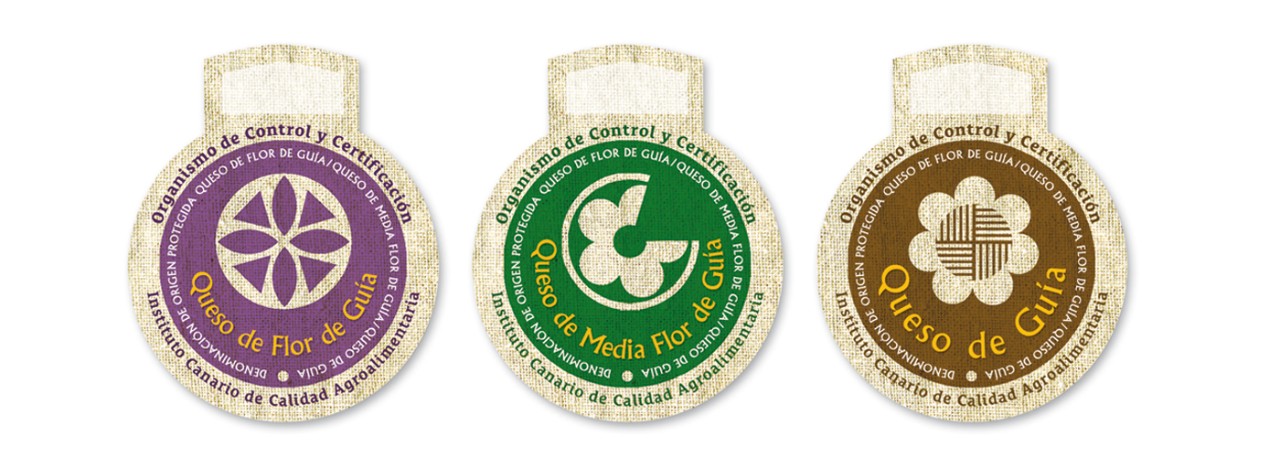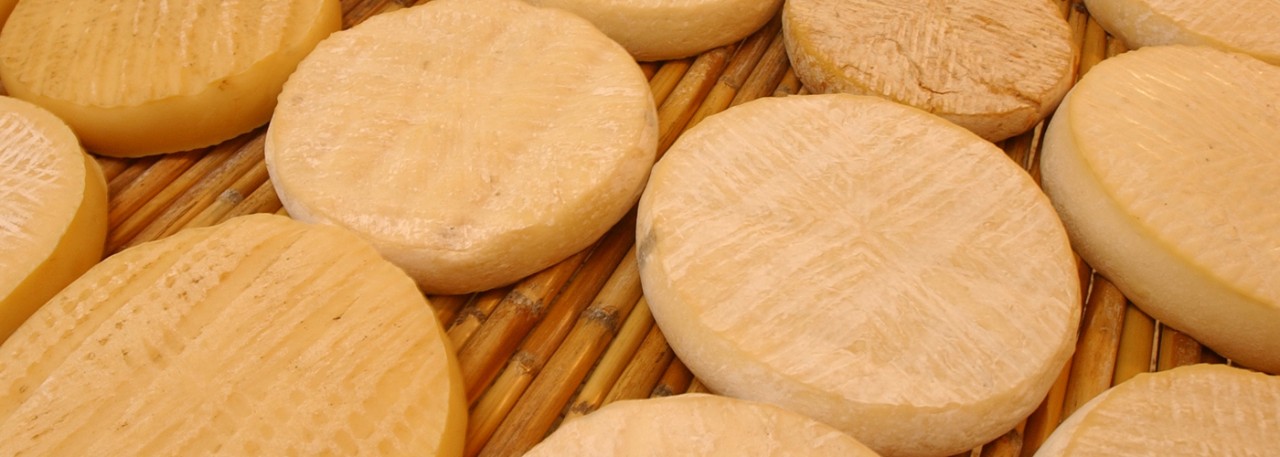.png.transform/rendition-xs/image_image%20(1).png)
Queso de Flor de Guía-Queso de Media Flor de Guía-Queso de Guía PDO
The following types and definitions of cheese:
Flor de Guía cheese: Whole milk or semi-skimmed, made primarily with Canary island sheep's milk, in which the milk is coagulated using exclusively vegetable rennet derived from the thistle flower (cynnara spp.).
Media Flor de Guía cheese: Whole milk or semi-skimmed, made primarily with Canary island sheep's milk, in which the milk is coagulated using more than 50% vegetable rennet derived from the thistle flower (cynnara spp.).
Guía cheese: Whole milk or semi-skimmed, made primarily with Canary island sheep's milk, in which the milk is coagulated using animal and/or vegetable rennet and/or other authorized fermenting agents.
Other notes
The cheeses are cylindrical in shape, with a height of between 4 and 8 cm / 1.5 and 3.1 in, a diameter of between 20 and 30 cm / 7.8 and 11.8 in and they weigh from 2 to 5 kg / 4.4 to 11 lb.
The chemical nature of these cheeses vary depending on their maturity, presenting the following minimum values:
Flor de Guía cheese:
Proteins: 22.50% (dry extract).
Fat: 29.50% (dry extract).
Dry extract: 56.50%.
Media Flor de Guía cheese:
Proteins: 23.50% (dry extract).
Fat: 27.50% (dry extract).
Dry extract: 55.50%.
Guía cheese:
Proteins: 24.10% (dry extract).
Fat: 27.50% (dry extract).
Dry extract: 57.00%.
Production / Processing method
Reception of raw materials: the milk obtained from manual or mechanical milking is then filtered and in some cases previously washed and decanted rock salt is added in amounts that should not exceed 25 to 30 g / 0.88 to 1.06 oz of salt for every hundred liters of milk.
Adding the rennet: this is done using the traditional method, which consists in adding the rennet and salt simultaneously when the milk reaches a temperature of between 28 and 35ºC (82.4 and 95ºF). The rennet can be either animal or vegetable. Animal rennet is obtained from the stomachs of kid goats and lambs. This rennet is dissolved in milk or warm water and added to the milk. Commercially produced rennet can also be used and is obtained from separating out the coagulating enzymes. Vegetable rennet is obtained from thistle flowers, from the dried flower heads of the thistle varieties cynara cardunculus var. ferocissima and cynara scolymus.
Only vegetable rennet is used to make Flor de Guía cheese, specifically the aqueous extract of the cynara cardunculus var. ferocissima and cynara scolymus thistle flowers. For the curdling process, the milk remains at a temperature of between 28 and 35ºC (82.4 and 95ºF) for a period of 60 to 90 minutes.
To make Media Flor de Guía cheese, the process of curdling the milk is done at a temperature of between 28 and 38ºC (82.4 and 100.4ºF) for a maximum period of one hour. An equal amount or more than 50% of vegetable rennet is used (cynara cardunculus var. ferocissima and cynara scolymus) and the remainder is other types of rennet or authorized enzymes. To make Guía cheese, the process of curdling the milk is carried out at a temperature of between 30 and 38ºC (86 and 100.4ºF) for a maximum period of one hour, using rennet or authorized enzymes, including vegetable rennet.
Cutting the curd and draining the whey: once the curd has been obtained it is cut using the typical lyres or by hand until the desired size of grain is achieved (grain of rice to chick pea size). The curd is left to rest, allowing the whey to drain away.
Molding and pressing: the base used for this stage is called a "cheese press". The cheese press used for Flor cheese can have a symmetrical geometric flower stamped in the centre, which may be the same or similar to the logo used for the Protected Designation of Origin.
Molding is done either manually or mechanically, placing the curd paste into the "ring". The partially pressed paste is then pressed for the exact amount of time required to obtain a homogenous stodgy mass.
Salting: to complement previous salting, or when this has not yet been done, dry salting is used, placing a little marine rock salt into the cheese press and also sprinkling salt over the top side of the cheese; the cheese then stays in the ring for about 24 hours. Moist salting can be done, under strict hygiene and health conditions.
Ripening: the protected cheeses have a minimum ripening period of fifteen days. During the ripening period, the cheeses are turned, cleaned and coated so they acquire their distinctive features. Coating is done by applying animal fat or edible vegetable oil, in cheeses over 60 days old. Pimentón (a type of Spanish paprika) or gofio (maize flour) can also be used. The products used in the coating process must appear on the label in compliance with current legislation.
Geography / Relief and climate
The geographical production area, despite being relatively small (136.62 km2 / 52.74 mi2) has a great diversity of micro-climates, caused by its land features. The perimeter of this area looks like a very irregular triangle, with a sharp tip in the island's interior, at an altitude of over 1,500 m / 4921.2 ft, which is another major climate factor.
The climate conditions in the municipality of Santa María de Guía are derived from its northerly position, with three altitudes, whilst Moya is influenced by its windward location and is wetter and rainier on medium high and high ground, In Gáldar, which is lower than 400 m / 1312.3 ft conditions are drier, with micro-climates that give the cheese its special features.
In these municipalities there are nearly a thousand plant species growing wild, around a hundred of which are endemic, a result of the micro-climates and the different altitudes. Among the species that grow wild, many are native forage plants and give the protected cheeses the distinctive appearance, smell and flavor that set them apart from others and link them to the place where they are produced.
Regulatory Council
Canary Island Institute of Agro-Food Quality (ICCA)
Avda. Buenos Aires, 5 - Edif. Tres de Mayo - Planta 4ª
38071 Santa Cruz de Tenerife (Canary Islands)
Tel: (+34) 922 592 735
icca.cagpa@gobiernodecanarias.org
Gobiernodecanarias.org/agricultura/icca/calidad/Quesos/florGuia
Sources:
- Spanish Ministry of Agriculture
Coating is done by applying animal fat or edible vegetable oil, in cheeses over 60 days old.


- Flor de Guía 1
- Flor de Guía 2

Santa Cruz de Tenerife (Canary Islands)
